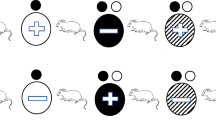Abstract
Two experiments examining the development of odor-based double-alternation patterning under concurrent food and water deprivation, but food versus water reinforcement, are reported. In both experiments patterning was established only by animals receiving food reinforcement. Shifting type of reinforcer (i.e., food to water, and vice versa) resulted in an immediate and pronounced change in performance (Experiment 1). Increasing the duration of water deprivation (Experiment 2) produced an increase in general performance level, but did not result in the development of patterning by water-reinforced animals. These results would appear to be supportive of an ethologically based interpretation, such as optimal foraging theory.
Similar content being viewed by others
References
AMSEL, A. (1958). The role of frustrative nonreward in noncontinuous reward situations. Psychological Bulletin, 55, 102–119.
AMSEL, A. (1962). Frustrative nonreward in partial reinforcement and discrimination learning: Some recent history and theoretical extension. Psychological Review, 69, 300–328.
BAUM, W. M. (1983). Studying foraging in the psychological laboratory. In R. L. MELLGREN (Ed.), Animal cognition and behavior (pp. 253–283). Amsterdam: North Holland Press.
BLOOM, J. M., & PHILLIPS, J. M. (1973). Conspecific odors as discriminative stimuli in the rat. Behavioral Biology, 8, 279–283.
COLLERAIN, I. (1978). Frustration odor of rats receiving small numbers of prior rewarded running trials. Journal of Experimental Psychology: Animal Behavior Processes, 4, 120–130.
COLLERAIN, I. J., & LUDVIGSON, H. W. (1977). Hurdle-jump responding in the rat as a function of conspecific odor of reward and nonreward. Animal Learning & Behavior, 5, 177–183.
COTMAN, C. W., & MCGAUGH, J. L. (1980). Behavioral neuroscience: An introduction. New York: Academic Press.
DAVIS, S. F., BURNS, R. A., HOWARD, A. J., & VOORHEES, J. W. (1982). Odor-based double-alternation patterning as a function of various types of liquid reinforcement. The Psychological Record, 32, 225–234.
DAVIS, S. F., PRYTULA, R. E., HARPER, W. E., TUCKER, H. K., LEWIS, C., & FLOOD, L. (1974). Double-alternation runway performance as a function of inter- and intra-reinforcement odor cues. Psychological Reports, 35, 787–793.
DAVIS, S. F., PRYTULA, R. E., NOBLE, M. J., & MOLLENHOUR, M. N. (1976). Motivational specificity of the signal value of odor cues. Animal Learning & Behavior, 4, 407–410.
DAVIS, S. F., PRYTULA, R. E., & VOORHEES, J. W. (1979). Odor-donor cue control of runway performance: A further examination. Bulletin of the Psychonomic Society, 13, 141–144.
DAVIS, S. F., WHITESIDE, D. A., BRAMLETT, J. A., & PETERSEN, S. H. (1981). Odor production and utilization under conditions of nonreward and small reward. Learning and Motivation, 12, 364–382.
GRICE, G. R., & DAVIS, J. D. (1957). Effect of irrelevant thirst motivation on a response learned with food reward. Journal of Experimental Psychology, 53, 347–352.
LUDVIGSON, H. W., & SYTSMA, D. (1967). The sweet smell of success: Apparent double-alternation in the rat. Psychonomic Science, 9, 283–284.
MELLGREN, R. L., MISASI, L., & BROWN, S. W. (1984). Optimal foraging theory: Prey density and travel requirements in Rattus norvegicus. Journal of Comparative Psychology, 98, 142–153.
MORRISON, R. R., & LUDVIGSON, H. W. (1970). Discrimination by rats of conspecific odors of reward and nonreward. Science, 167, 904–905.
PHILLIPS, J. M., & BLOOM, J. M. (1971). Control of conspecific odors in the runway. Psychological Reports, 29, 838.
PRYTULA, R. E., & DAVIS, S. F. (1974). Runway performance as a function of positively and negatively correlated olfactory cues. Psychological Reports, 35, 735–740.
PRYTULA, R. E., & DAVIS, S. F. (1976). The relationship between locus of odor cues and double-alternation responding in the rat. Animal Learning & Behavior, 4, 352–356.
PRYTULA, R. E., DAVIS, S. F., & FANNING, J. J. (1981). The acquisition of a running response as a function of odor buildup, squad rotation, and introduction of naive subjects. Animal Learning & Behavior, 9, 556–560.
SEAGO, J. D., LUDVIGSON, H. W., & REMLEY, N. R. (1970). Effects of anosmia on apparent double alternation in the rat. Journal of Comparative & Physiological Psychology, 71, 435–442.
TAYLOR, R. D., & LUDVIGSON, H. W. (1983). Odor-mediated alleyway performance as a function of squad position with varied donors. Bulletin of the Psychonomic Society, 21, 217–220.
TEEL, K. S., & WEBB, W. B. (1951). Response evocation on satiated trials in the T-maze. Journal of Experimental Psychology, 41, 148–152.
VERPLANCK, W. S., & HAYES, J. R. (1953). Eating and drinking as a function of maintenance schedule. Journal of Comparative and Physiological Psychology, 46, 327–333.
VOORHEES, J. W., & REMLEY, N. R. (1981). Mitral cell responses to the odors of reward and nonreward. Physiological Psychology, 9, 164–170.
WEAVER, M. S., & DAVIS, S. F. (1983). Motivational specificity of the signal value of odor cues: A reconsideration and extension. The Emporia State Research Studies, 32, 1–48.
WEAVER, M. S., DAVIS, S. F., & MOORE, S. A. (1984). Odor-based runway performance as a function of deprivation state, squad size, and subject-rotation procedures. Bulletin of the Psychonomic Society, 22, 155–158.
WEBB, W. B. (1949). The motivational aspect of an irrelevant drive in the behavior of the white rat. Journal of Experimental Psychology, 39, 1–14.
Author information
Authors and Affiliations
Rights and permissions
About this article
Cite this article
Davis, S.F., Nash, S.M., Anderson, B.J. et al. Odor-Based Runway Performance of Rats as A Function of Type of Reinforcer and Multiple Deprivation Conditions. Psychol Rec 35, 337–351 (1985). https://doi.org/10.1007/BF03395856
Published:
Issue Date:
DOI: https://doi.org/10.1007/BF03395856




